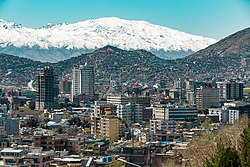List of cities in Afghanistan
Afghanistan has about 26 million people. 5.7 million live in urban areas. The rest live in rural areas or countryside.[1] The following are fourteen cities of Afghanistan in order of population. The estimates are from 2006.[2]

- Kabul - 1,925,548 [3]
- Kandahar - 468,200 [4]
- Herat - 397,456 [5]
- Mazar-i-Sharif - 375,181 [6]
- Kunduz - 230,600 [7]
- Jalalabad - 205,423 [8]
- Lashkar Gah - 201,546 [9]
- Taluqan - 194,471 [10]
- Puli Khumri - 191,640 [11]
- Khost - 160,214 [12]
- Ghazni - 154,618 [13]
- Sheberghan - 148,329 [14]
- Sari Pul - 115,463 [15]
- Farah - 109,409 [16]
Ancient names
Ancient names of places or cities in Afghanistan:
| Current city and region | Ancient name |
|---|---|
| Kabul | Chabolo, Kophene,[17] Gaofū, Kābūrā |
| Ghazni | Ghaznīn, Ghazna (Gajant - Sanskrit, Having wealth which can be carried on the elephant) |
| Balkh | Bactra, Bokhdī |
| Herat | Haraiva, Harī, Aria |
| Laghman | Lampaka [17] |
| Jalalabad | Adinapur[18] |
| Kandahar | Arachosia[17] |
| Lashkar Gah | Bost or Bust |
Gallery
- Images of Afghan cities
The Aino Mina new housing project on the outskirts of Kandahar, which is the second largest Afghan city.
Herat, the third largest city
Mazar-i-Sharif, the fourth largest city
Jalalabad, the sixth largest city
Khost, the tenth largest city
List Of Cities In Afghanistan Media
Kabul is the only city in Afghanistan with over a million residents
Kandahar is the second largest city and the former capital of Afghanistan. The city is located in southern Afghanistan.
Herat is the third largest city and is located in western Afghanistan
Mazar-i-Sharif is the fourth largest city and is located in northern Afghanistan
Jalalabad, the fifth-largest city, located in eastern Afghanistan
Lashkargah, capital of Helmand Province in southern Afghanistan
Section of Ghazni, capital of Ghazni Province
Khost, capital of Khost Province in the east of the country
Fayzabad, capital of Badakhshan Province of Afghanistan
Zaranj, capital of Nimruz Province in southwestern Afghanistan
References
- ↑ Mohammad Jawad Sharifzada, ed. (November 20, 2011). Afghanistan's population reaches 26m. Pajhwok Afghan News. http://www.pajhwok.com/en/2011/11/20/afghanistans-population-reaches-26m. Retrieved January 11, 2012.
- ↑ "Provincial Development Plan". Afghanistan Statistical Yearbook 2006, Central Statistics Office. Ministry of Rural Rehabilitation and Development. 2006. Retrieved 2011-01-13.[dead link]
- ↑ "B. Demography and Population" (PDF). Afghanistan Statistical Yearbook 2006, Central Statistics Office. Ministry of Rural Rehabilitation and Development. Archived from the original (PDF) on 2011-07-27. Retrieved 2011-01-13.
- ↑ "B. Demography and Population" (PDF). Afghanistan Statistical Yearbook 2006, Central Statistics Office. Ministry of Rural Rehabilitation and Development. Archived from the original (PDF) on 2012-03-21. Retrieved 2011-01-13.
- ↑ "B. Demography and Population" (PDF). Afghanistan Statistical Yearbook 2006, Central Statistics Office. Ministry of Rural Rehabilitation and Development. Archived from the original (PDF) on 2012-03-21. Retrieved 2011-01-13.
- ↑ "B. Demography and Population" (PDF). Afghanistan Statistical Yearbook 2006, Central Statistics Office. Ministry of Rural Rehabilitation and Development. Archived from the original (PDF) on 2012-04-25. Retrieved 2011-01-13.
- ↑ "B. Demography and Population" (PDF). Afghanistan Statistical Yearbook 2011, Central Statistics Office. Central Statistics office. Archived from the original (PDF) on 2016-03-13. Retrieved 2011-01-13.
- ↑ "B. Demography and Population" (PDF). Afghanistan Statistical Yearbook 2006, Central Statistics Office. Ministry of Rural Rehabilitation and Development. Retrieved 2011-01-13.[dead link]
- ↑ "B. Demography and Population" (PDF). Afghanistan Statistical Yearbook 2006, Central Statistics Office. Ministry of Rural Rehabilitation and Development. Archived from the original (PDF) on 2019-05-28. Retrieved 2011-01-13.
- ↑ "B. Demography and Population" (PDF). Afghanistan Statistical Yearbook 2006, Central Statistics Office. Ministry of Rural Rehabilitation and Development. Archived from the original (PDF) on 2017-12-01. Retrieved 2011-01-13.
- ↑ "B. Demography and Population" (PDF). Afghanistan Statistical Yearbook 2006, Central Statistics Office. Ministry of Rural Rehabilitation and Development. Retrieved 2011-01-13.[dead link]
- ↑ "B. Demography and Population" (PDF). Afghanistan Statistical Yearbook 2006, Central Statistics Office. Ministry of Rural Rehabilitation and Development. Retrieved 2011-01-13.[dead link]
- ↑ "B. Demography and Population" (PDF). Afghanistan Statistical Yearbook 2006, Central Statistics Office. Ministry of Rural Rehabilitation and Development. Retrieved 2011-01-13.[dead link]
- ↑ "B. Demography and Population" (PDF). Afghanistan Statistical Yearbook 2006, Central Statistics Office. Ministry of Rural Rehabilitation and Development. Retrieved 2011-01-13.[dead link]
- ↑ "B. Demography and Population" (PDF). Afghanistan Statistical Yearbook 2006, Central Statistics Office. Ministry of Rural Rehabilitation and Development. Archived from the original (PDF) on 2012-03-12. Retrieved 2011-01-13.
- ↑ "B. Demography and Population" (PDF). Afghanistan Statistical Yearbook 2006, Central Statistics Office. Ministry of Rural Rehabilitation and Development. Retrieved 2011-01-13.[dead link]
- ↑ 17.0 17.1 17.2 The Ancient Geography of India by Alexander Cunningham .
- ↑ Gazetteer of the Peshawar District 1897-98 Page 55













